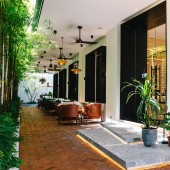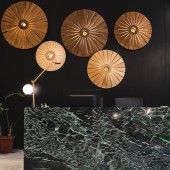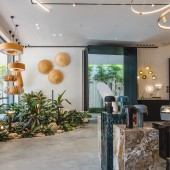Eco-Luminance Oasis Retails Shop by Rix Yap |
Home > Winners > #155982 |
 |
|
||||
| DESIGN DETAILS | |||||
| DESIGN NAME: Eco-Luminance Oasis PRIMARY FUNCTION: Retails Shop INSPIRATION: Inspired by the idea of lights merging with greenery, we envisioned a space where the vibrant hues of nature blend effortlessly with artificial lighting. This fusion transforms the traditional boundaries, creating a dynamic environment where the artificial coexists with the lively. Our creative goal is to provide a versatile space that effortlessly accommodates multiple functions. By incorporating dual merging elements, we not only offer a visually stunning atmosphere but also ensure organizational efficiency. Comfortable artificial lighting serves as the backbone of the design, contributing to a welcoming space. "Verde Fusion" epitomizes innovation and uniqueness, offering a transformative experience where the boundaries between indoors and outdoors dissolve, creating a space that is both functional and aesthetically pleasing. UNIQUE PROPERTIES / PROJECT DESCRIPTION: Verde Light’s company vision is going beyond mere illumination. In their pursuit of exceptional lighting, they embrace both light and shadow, to enhance every texture, color, and form for the pleasure of their clientele. With a strong commitment to sustainability, Verde Light explores veneer lighting that incorporates nature driven materials and premium LED components, aiming to extend the lifespan of light fixtures and minimize electronic waste. Design Issue: Despite being a trendy lighting brand with a compelling vision, Verde Light lacks a distinctive spatial identity that resonates with a broader audience. Design Concept: The primary goal of the design concept is to establish a unique spatial identity that enhances Verde Light's brand equity. Design Strategy: 1. Biophilic Design: Verde Light's founders envisioned their new showroom as a fusion of biophilic and light industrial aesthetics. Consequently, the design incorporates green elements and natural lighting to brighten the interior environment. A central large potted plant serves as a tribute to mother earth and her positive influences. The sound of rain falling on red brick paving stones, which then collects in a specially designed water pond in the yard, further reinforces the integration of nature within the space. 2. Blending exterior and interior spaces: A significant emphasis has been placed on creating a facade that seamlessly connects outdoor and indoor spaces. Large open window panes allow natural sunlight to flood the interior, while carefully placed bamboo plants on the sidewalks blend with the interior decor. Strategically positioned outdoor furniture visually extends into the interior space, creating a harmonious transition. 3. Spatial Experience: The new showroom is designed to transcend its role as a retail store. Beyond showcasing products as the main highlight, the space offers various areas for customers to experience how lighting can transform spatial perceptions through different illumination strategies. The overall ambiance is crafted to project the image of a cozy, inviting home, enhancing the retail experience. 4. Multi-functionality: In addition to serving as a lighting showroom and office space, this versatile environment can also function as a relaxation hub, host events, and serve as a pop-up art gallery. This adaptability is facilitated by mobile furniture and a clean backdrop suitable for projections. 5. Site adaptation: Situated within an industrial estate, the showroom stands out as an oasis amidst a concrete jungle. The architectural facade is adorned with green and natural elements, making the building a visual standout and reinforcing Verde Light's commitment to nature and sustainability. This comprehensive design strategy aims to not only address the spatial identity issue but also create an engaging, multifunctional, and environmentally conscious space that aligns seamlessly with Verde Light's core values and aspirations. OPERATION / FLOW / INTERACTION: Choose Low-Maintenance Plants: Choosing for plants that are well-suited to the local climate and require minimal care. Consider drought-resistant plants for outdoor spaces to reduce water consumption. Implement Drip Irrigation: Install drip irrigation systems for outdoor plants to optimize water usage and minimize waste. Use rain sensors to avoid unnecessary watering during rainy periods. Select Native Plants: Choose native plants for outdoor landscaping as they are adapted to the local environment and require less maintenance. Mulching: Apply mulch around outdoor plants to retain soil moisture, suppress weeds, and regulate soil temperature. Regular Pruning: Schedule regular pruning to maintain plant health, encourage new growth, and shape plants for aesthetic purposes. Composting: Set up a composting system to recycle organic waste, creating nutrient-rich compost for the plants. Natural Pest Control: Use natural and organic pest control methods to minimize the impact on the environment. Introduce beneficial insects that can control pest populations LED Lighting: Choose energy-efficient LED lights for both indoor and outdoor spaces. LED lights consume less energy and have a longer lifespan compared to traditional lighting options. Automated Lighting Controls: Implement automated lighting controls to optimize energy usage. Use sensors to adjust lighting levels based on occupancy and natural light availability. Regular System Updates: Keep smart lighting systems and software up-to-date to ensure optimal performance and take advantage of the latest energy-saving features. PROJECT DURATION AND LOCATION: Design stage : 1 month Construction stage : 5 months Singapore FITS BEST INTO CATEGORY: Interior Space and Exhibition Design |
PRODUCTION / REALIZATION TECHNOLOGY: Red bricks as pavers for outdoor walkway: Red bricks are a durable and classic choice for outdoor walkways. Ensure proper installation for stability and longevity. Consider incorporating patterns or designs for visual interest. Natural wood as window frame with dark lacquer: Natural wood adds warmth and a connection to nature. Dark lacquer provides a modern and sophisticated finish. Regular maintenance is important to protect the wood from weathering. Cement Screeding floor finishing: Cement screed provides a smooth and contemporary flooring option. It's versatile and can be used in various design styles. Consider using rugs or carpets for added comfort in certain areas. Planter boxes and indoor design elements: Planter boxes can introduce greenery, improving indoor air quality. Choose plants that thrive in indoor conditions and complement the overall design. Consider incorporating natural materials like stone or wood for indoor design elements. Ventilation Blocks as Feature Wall: Ventilation blocks allow for air circulation while adding a unique design element. They can be strategically placed for both form and function. Consider incorporating integrated lighting for dramatic effects. When working with natural materials, it's essential to consider their maintenance requirements, lifespan, and compatibility with the overall design concept. Additionally, integrating sustainable practices in sourcing and construction processes can enhance the eco-friendly aspects of your project. It's recommended to work closely with architects, designers, and contractors to ensure the proper selection and installation of these materials for a successful and sustainable design outcome. Smart Lighting Control: Use smart lighting systems that allow control through mobile apps. This enables users to adjust lighting levels, colors, and ambiance remotely. Consider integrating voice control systems like Amazon Alexa or Google Assistant for hands-free operation. Color Temperature Control: Smart lighting systems often offer a range of color temperatures, allowing you to adjust the warmth or coolness of the light based on the time of day or desired mood. Consider incorporating tunable white lights for spaces where adjustable color temperature is important. Energy Efficiency: Smart lighting technology often includes energy-efficient features, such as dimming capabilities and motion sensors that can automatically turn lights off when not needed. This can contribute to energy savings and sustainability. Automation and Scheduling: Create lighting schedules for different times of the day or activities. For example, you can set the lights to simulate sunrise in the morning or create a cozy ambiance in the evening. Automation can enhance security by simulating presence when you're away. Integration with Other Smart Home Devices: Ensure compatibility with other smart home devices, creating a seamless and integrated experience. For example, lights can be synchronized with smart thermostats or security systems. Explore options for compatibility with popular smart home platforms like Apple HomeKit, Google Home, or Amazon Echo. User-Friendly Interfaces: Choose smart lighting systems with user-friendly interfaces to make it accessible for all users. Consider the ease of setup and customization to tailor the lighting experience to individual preferences. Upgradability and Future Compatibility: Select smart lighting solutions that allow for future upgrades or expansion. This ensures that your system can adapt to evolving technologies and user needs. Integrating smart lighting into your design not only adds a layer of convenience but also aligns with the contemporary and sustainable aspects of your project. It's essential to collaborate with technology experts during the planning and implementation phases to ensure a seamless integration of smart lighting systems into your overall design. SPECIFICATIONS / TECHNICAL PROPERTIES: GFA : 5500sqft Two story retail shop TAGS: Sustainable, unique, timeless RESEARCH ABSTRACT: Market Analysis: Research the current trends and demands in the lighting industry in Singapore. Identify key competitors and their offerings in terms of product range, pricing, and customer service. Sustainable Lighting Solutions: Differentiate the lighting shop by focusing on sustainable and energy-efficient lighting solutions. Offer a range of LED lights, smart lighting systems, and solar-powered options to cater to environmentally conscious consumers. Customization Services: Provide customization services for lighting fixtures to meet the unique preferences and needs of customers. Offer personalized design consultations to create bespoke lighting solutions for both residential and commercial clients. Smart Home Integration: Specialize in smart lighting systems that can be seamlessly integrated into smart home setups. Provide expertise in setting up automated lighting controls, voice-activated systems, and other smart home features. Educational Workshops: Differentiate your shop by organizing workshops and seminars on lighting design, trends, and energy efficiency. Position your business as a source of knowledge and expertise in the industry. CHALLENGE: To full fill client budget and their expectation. To design and change the structural within the singapore building code. Try to reuse all the old elements but expose to be feature or hide it to be part of the new wall. ADDED DATE: 2023-11-27 15:39:29 TEAM MEMBERS (1) : IMAGE CREDITS: Image #1: Photographer Lim Guan Wen, Image #2: Photographer Lim Guan Wen, Image #3: Photographer Lim Guan Wen, Image #4: Photographer Lim Guan Wen, Image #5: Photographer Lim Guan Wen Video Credit : Ng Lee Foong PATENTS/COPYRIGHTS: For copyrights: "Copyrights belong to R+ Studio, 2023" |
||||
| Visit the following page to learn more: https://r-plusstudio.com/ | |||||
| AWARD DETAILS | |
 |
Eco-Luminance Oasis Retails Shop by Rix Yap is Winner in Interior Space and Exhibition Design Category, 2023 - 2024.· Press Members: Login or Register to request an exclusive interview with Rix Yap. · Click here to register inorder to view the profile and other works by Rix Yap. |
| SOCIAL |
| + Add to Likes / Favorites | Send to My Email | Comment | Testimonials | View Press-Release | Press Kit |







